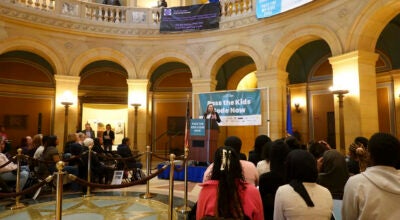Election sets stage for more gridlock at Minnesota Capitol
Published 7:47 am Thursday, November 5, 2020
|
Getting your Trinity Audio player ready...
|
MINNEAPOLIS — The election has set the stage for more partisan gridlock at the Minnesota Capitol, with Republicans appearing likely Wednesday to hang onto their slim majority in the Senate and Democrats poised to keep a diminished majority in the House.
With little change in the balance of power, Democrats and Republicans are likely to continue to struggle to find common ground on major issues. The two sides were unable over the past two years to agree on a public works package known as a bonding bill until a special session last month. And they’ve bitterly split over whether to continue to allow Democratic Gov. Tim Walz to deal with the coronavirus pandemic via executive orders, with few checks and balances from the Legislature.
Two Minnesota congressional races were still too close to call Wednesday. U.S. Reps. Jim Hagedorn, a Republican, and Angie Craig, a Democrat, held narrow leads over challengers Dan Feehan and Tyler Kistner. Both Hagedorn and Craig claimed victory, but their opponents did not immediately concede. Absentee ballots postmarked by Election Day will be counted as long as they arrive by next Tuesday, meaning some races might not be settled until then.
The votes trickled in after a good night for Democrats in statewide races. Joe Biden won Minnesota’s 10 electoral votes and Tina Smith was reelected to the U.S. Senate. Both victories came on the strength of heavy Democratic turnout in Hennepin and Ramsey Counties, which include Minneapolis and St. Paul. But that didn’t translate into many Democratic gains elsewhere across Minnesota. In the biggest GOP victory, former lieutenant governor and former state senator Michelle Fischbach unseated Democratic Rep. Collin Peterson, who has represented western Minnesota for 30 years.
Peterson, who chairs the House Agriculture Committee, has seen voters in his heavily agricultural district shift sharply toward the GOP in recent elections.
“I respect their decision to move in a different direction,” Peterson said in a statement. “We ran a strong and positive campaign, but with the President winning this district by 30 points again, and the millions in outside money that was spent to attack me, the partisan tilt of this district was just too much to overcome.”
Several races in both chambers of the Legislature remained unsettled Wednesday, and at least three House races were close enough to trigger automatic recounts if the trailing candidate requests, Secretary of State Steve Simon said.
“Based on current results, I am confident that we have retained the DFL House Majority,” Democratic House Speaker Melissa Hortman said in a statement. “Minnesotans have clearly rejected the divisiveness of Donald Trump in favor of Vice President Biden and the House DFL vision of a Minnesota that works better for everyone.”
Senate Republican leaders did not immediately comment on the results because the ballots were still being counted. But House Minority Leader Kurt Daudt took pride in his caucus’ gains, saying they defied pundits’ expectations.
“Last night’s results make clear that Minnesotans do not support the Democrats’ extreme agenda of defunding the police and massive tax hikes,” Daudt said in a statement.
Democrats had mounted a major push to take control of the Senate, but apparently fell short of the net flip of two seats that they needed. Coupled with continued Democratic control of the House and the governor’s office, a Senate majority would have given Democrats power over how Minnesota deals with a projected $4.7 billion budget deficit and the redrawing of congressional and legislative district maps.
But the results indicate that Walz, House Democrats and Senate Republicans must continue to forge difficult compromises on budget and policy issues, as they have for the past two years. Senate Republicans hold a 35-32 majority at the moment, while the House Democratic margin is 75-59. If history is a guide, the two parties will likely stalemate over redistricting, and the task will probably fall to the courts once again.
Simon estimated Minnesota’s voter turnout at 78.1%. The state’s modern turnout record was 78.77% in 2004. Simon said the turnout figure would grow as more absentee ballots were counted, and that Minnesota could end up No. 1 in the country for turnout this year.
“Regardless of whether we are number one or not, I think we pulled off something really extraordinary in Minnesota,” he said in a conference call with reporters.
Officials have until Thursday to count absentee ballots that were received before polls closed. Due to the increased reliance on absentee voting due to COVID-19 concerns, a consent decree reached in state court gives elections officials until next Tuesday to count ballots that arrive after polls closed, as long as they were postmarked by Nov. 3 or there is no evidence they were mailed after Election Day.
Last week, a federal appeals court ruled that ballots coming in after Election Day must be segregated from other ballots. The order didn’t outright block Minnesota’s seven-day extension, but it raised the specter that late-arriving votes might be invalidated in future court challenges. Simon said the late arrivals — which are expected to total fewer than the roughly 240,000 absentee ballots that had not been returned as of midday Wednesday — will be counted but kept separate.
“Minnesota has a lot to be proud of: High turnout, low conflict and that’s what you want in an election,” Simon said. “It’s not over. … We want to count every last vote for every contest in Minnesota.”





